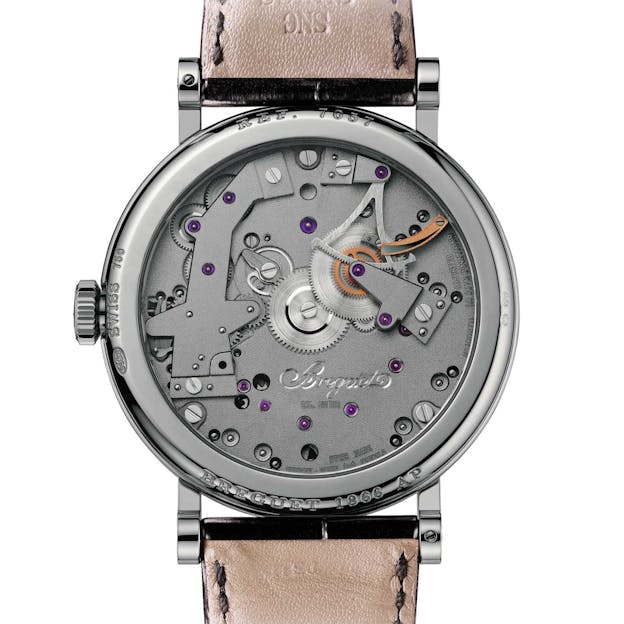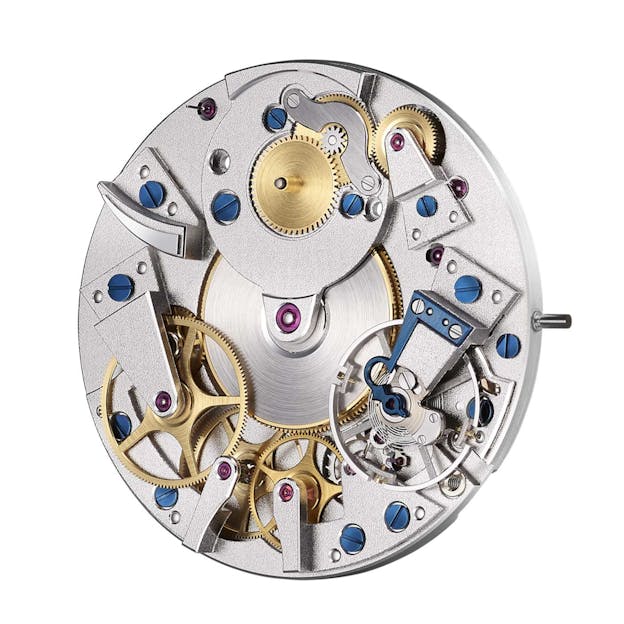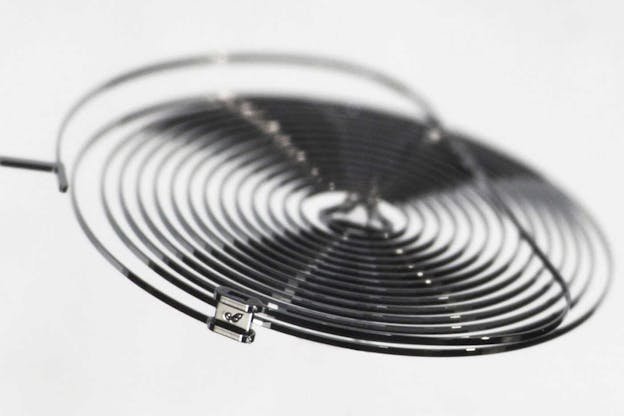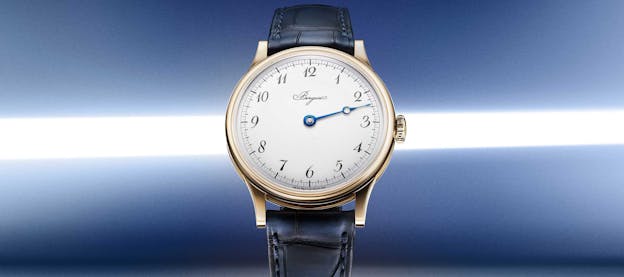In Depth: Breguet’s New Classique Souscription 250th Anniversary Pays Tribute To A Simple Masterpiece
It’s a near exact reincarnation of the original Souscription watches, re-imagined as a wristwatch.
The Souscription watches produced by Breguet, beginning in 1796, get their name from the fact that they were sold on the subscription (“souscription” in French) model; if you wanted one, you put down a 25% deposit, with the balance payable on delivery. The Souscription watches took advantage of the growing market, after the Revolution, for reliable, accurate, high quality watches and they were very successful, with around 700 in total being made. Prices were for watches from such a famous maker, relatively affordable and ranged from 600 to around 800 francs (expensive but much less so that Breguet’s garde temps high precision watches, which could be at least eight times more) and the designs were minimalist both aesthetically and mechanically, but with no corners cut.

The example which we had in 2023, which was originally sold in 1805, is a great example of the type. Case and dial work remained exacting, with the use of fine engine turning characteristic of so many Breguet watches, and the movements were strong, simple, and constructed for long term reliability and precision.

The movements of Souscription watches are dominated by the central mainspring barrel, and had a bimetallic compensation curb (not a bimetallic balance; the temperature compensation curb is under the balance and works by sliding the regulator index back and forth as the strip expands and contracts) and it uses Breguet’s pare-chute antishock system, as well as his version of the ruby cylinder escapement – according to George Daniels, probably the best cylinder escapement ever made. In “The Art Of Breguet,” Daniels wrote:
“The [cylinder escapements of Breguet] performed so well and with such increased consistency of rate, that temperature errors previously swamped by general bad performance now needed correction. For this reason, except in his smallest watches, Breguet’s ruby cylinder escapements employ a compensation curb.”
Breguet in the modern era, launched its first Souscription influenced watches in 2005; these are the aptly named Tradition models,

The Tradition models adopted the basic gear train layout of the Souscription watches for a modern wristwatch, with the central mainspring barrel and the same basic arrangement of the gear train (however, there is an additional wheel coming off the mainspring barrel, between it and the first large wheel of the going train on the left). The major difference between a Tradition movement (caliber 507 DR1) is that in the Tradition watches, the there are minute hands (the original Souscription watches only had an hour hand) and the movement is inverted so that the going train and barrel are on the dial side of the watch, with the keyless works for winding and setting on the back, instead of under the dial as is usually the case.

In the original Souscriptions (there’s an excellent deconstruction and technical analysis at The Naked Watchmaker) the lone hour hand was mounted directly on the arbor of the mainspring barrel; in the 507 DR1, there is a separate set of motion works for the hour and minute hand, on the opposite side of the mainspring barrel from the going train itself.

The Classique Souscription 250th Anniversary
The Classique Souscription 250th Anniversary duplicates the clean, minimalist dial of the original Souscription models, which were made with both metal and enamel dials (the watch shown in the deconstruction at The Naked Watchmaker has an enamel dial, for example).

The dial is in fired vitreous enamel (or grand feu enamel) which has, as was the case in Breguet’s time, a minute “secret signature” engraved on it. In Breguet’s time this was done as an anti-counterfeiting measure; just as is the case today, well known makers had their work knocked off frequently and Breguet was enthusiastically faked even in his own lifetime. For the secret signature on the Anniversary Souscription model, Breguet uses a tradition pantograph from the 18th century which was acquired from the estate of George Daniels.


The secret signature is pretty secret – nearly invisible to the naked eye and as an anti-counterfeiting measure, still effective as anyone trying to fake a 250th Anniversary Souscription is unlikely to have access to an 18th century pantograph (although if there is anything for sure when it comes to fakes, where there’s a will, there’s a way).

As in Breguet’s time, the single large central hour hand is thermally blued over the flame of an alcohol lamp; the steel hand rests on minute copper shavings, to ensure even distribution of heat.

The case, surprisingly, foregoes the usual coin-edge case middle, instead opting for a simple horizontally brushed finish. I say “surprising” because you would naturally expect that detail – found on both the original Souscription watches as well as on the Tradition models – to be present, but at the scale of a wristwatch aiming for the radical simplicity of the Souscription, this is less an omission than a design decision (the Anniversary Souscription is 40mm x 10.8mm, the same diameter as the Tradition, although slightly thinner than the 7057, which is 40mm x 11.7mm). The Anniversary Souscription also uses more contemporary lugs than the straight lugs used in the rest of the Classique and Tradition collections, although their graceful curvature and spiraled tips have echoes of late 18th and early 19th century design; they remind me a little bit of the cabriole furniture legs which are an iconic feature of 18th century European furniture.

The case is made of a new proprietary gold alloy – according to Breguet, it’s simply called Breguet Gold, and it’s a mixture of gold, silver, copper, and palladium. The company describes the color as “blond” – it looks like a sort of intermediate between yellow gold and the more coppery color of red gold, which the use of palladium would seem to suggest (platinum and platinum group metals are often used in modern watchmaking alloys to prevent the copper from oxidizing and discoloring the metal). The engine turning on the caseback is a new one for Breguet – they’re calling it “Quai de l’Horloge” after the street on the island in the center of Paris – the Île de la Cité – where Breguet had his headquarters. The pointing ovals making up the pattern are a stylized outline of the Île de la Cité as seen from above.
Breguet Caliber VS00
The movement is a somewhat new one for Breguet – caliber VS00, which has plates and bridges gilded in Breguet gold. It’s large, for a wristwatch movement – 16 lignes, or approximately 36mm. The architecture is derived from the Tradition caliber 507, but with some interesting differences which make it a more exact representation of Breguet’s original Souscription movements.

The most immediately noticeable difference between the 507 calibers and the VS00 is the absence of the additional motion works necessary to support the hour and minute hands in the subdial at 12:00. Instead, the VS00, like the original Souscription calibers, has a single large cock for the central mainspring barrel, which is engraved with text from Breguet’s notes describing the Souscription movement. The arrangement of wheels and cocks is symmetrical on the vertical axis, with the first large train wheel and the balance on opposite sides of the mainspring. The first train wheel and balance are approximately the same diameter, as is the case in the original Souscription watches, and in the caliber 507 DR1 as well.
The overall aesthetic’s very close to the original Souscription caliber – more so than any of the current Tradition watches, which use a black, grey, and silver color palette, giving them a contemporary feel to balance the traditional train layout. Here, you’ve got the pleasing contrast between gold, polished steel, and heat blued steel that George Daniels admired so much in Breguet’s work, and emulated in its own.
Caliber VS00 has a four day power reserve out of a single mainspring barrel – if the hour hand is driven directly off the mainspring barrel, as in the original Souscription (I’m not sure whether or not it is) then the barrel turns eight times over the course of four days. One interesting feature is the balance spring – in the 507 calibers, the balance spring is silicon, with an overcoil. Making a silicon spring with an overcoil is a challenge because you can’t bend silicon the way you can bend traditional balance spring materials like carbon steel or Nivarox; silicon balance springs are etched from a flat wafer so they’re flat by default. In the 507 calibers Breguet, which for obvious reasons feels Breguet overcoils should be part of its technical vocabulary, gets around this problem by producing the terminal coil as a separate component, which is then attached by a tiny clamp to the outermost coil of the flat part of the silicon spring.

In the VS00, the balance spring isn’t silicon. Instead, it’s made from an alloy called Nivachron, which was co-developed by Audemars Piguet and Swatch Group, and which was announced in 2018. Nivachron is, according to SG, anywhere from 10 to 20 times more resistant to magnetism than a conventional Nivarox-type balance spring, and therefore an alternative to silicon. The Group has not publicly disclosed the composition of the alloy, other than to say that it’s titanium-based, although patents filed by Nivarox – FAR (the company which makes Nivarox alloy balance springs and which at one time had a near total monopoly on balance spring manufacture in the Swiss watch industry) indicate that the bulk of the material is niobium and titanium, with very small amounts of other elements.

Although Nivarox alloy balance springs are much more resistant to magnetism than carbon steel balance springs, they do have a disadvantage. Relatively weak magnetic field contamination – too weak for most owners to notice – can cause gradual changes in the ability of the alloy to resist alterations in its elasticity due to temperature change. One of the advantages of silicon is that it’s completely unaffected by magnetism, but it’s also relatively brittle and has to be handled carefully during service. The Nivachron alloy seems to combine the shock resistance and durability of Nivarox alloys with the antimagnetic properties of silicon, with the disadvantages of neither – something Breguet would have liked.
This is about as direct a connection to an original Souscription as Breguet is ever likely to make, both externally and internally. One handed watches are sometimes called “philosopher’s watches” as they orient you with respect to time, without making you feel as if the minute and seconds hands are micromanaging you; the original Souscription watches, thanks to their large diameter and very fine-tipped hour hands, could be read easily to within a five minute range thanks to the dots on the chapter ring (there is a dot at every five minutes) and probably close to a minute’s resolution if your eyes were good.

The same is true of the Anniversary Souscription – you feel more a sense of control over time, than that time has control over you. This was of course, part of the attraction of the original Souscription, which put precision timekeeping into the hands of a relatively large number of owners at a time when watches were, for the first time, becoming not just mechanical amusements for the wealthy, but actual precision timekeepers as well. Breguet was at the forefront of this transition, and his combination of mechanical genius, as well as a peerless eye for elegant, tasteful watch design which eerily anticipated much later design movements like Art Deco, made him a legend in his own time, and the Anniversary Souscription a reminder of this rare combination of exceptional talents – including, on top of everything else, a head for business – which makes Breguet influential even today.
The Breguet 250th Anniversary Classique Souscription: case, 18k “Breguet Gold” 40mm x 10.8mm, with satin brushed case middle; “Quai de l’Horloge” guilloché case back; water resistance, 30M. White grand feu enamel on gold base. Movement, Breguet caliber VS00 in Breguet Gold gilded brass, 16 ligne, 5.7mm diameter; hand wound, running at 21,600 vph in 21 jewels; single barrel with 96 hour power reserve; Nivachron balance spring with Breguet overcoil. Price, $48,700; non-limited production.
The 1916 Company is proud to be an authorized retailer for Montres Breguet.

